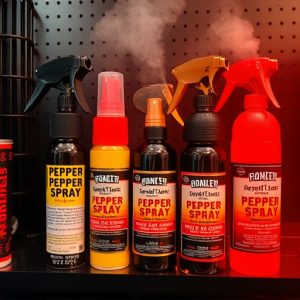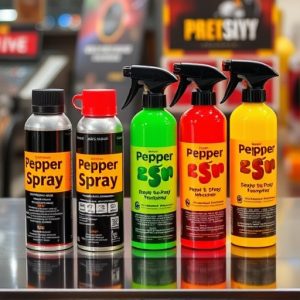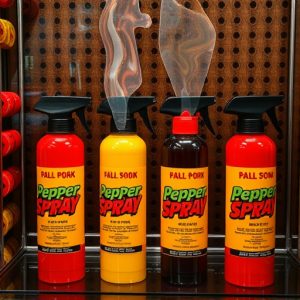Harnessing Pepper Spray Displays for Effective Wildfire Prevention and Suppression
Pepper spray displays have revolutionized both firefighter training and operational tactics for man…….
Pepper spray displays have revolutionized both firefighter training and operational tactics for managing wildfires. These sophisticated simulators realistically replicate the effects of actual pepper spray, enhancing first responders' readiness to handle real-world scenarios. By providing a safe environment for practicing the incapacitating effects of pepper spray, these displays significantly improve the safety of both personnel and communities. They are particularly valuable in preparing for the unpredictable nature of wildfires, potentially requiring the use of pepper spray as a last line of defense to protect lives and property. In active fire situations, pepper spray displays can create a protective barrier against flames, facilitating evacuations and allowing firefighters to strategize under hazardous conditions. Beyond training, these systems are employed tactically, using oleoresin capsicoid agents to suppress flames by irritating the fire's respiratory system, thereby reducing its intensity and limiting its spread. This method is environmentally friendly, minimizing ecological damage compared to traditional water-based methods. Pepper spray displays are particularly effective in areas where conventional techniques fall short, as seen during incidents like the Sonoma County wildfires, and have proven their worth in diverse environments, from vineyards to historical sites, contributing to sustainable fire management practices worldwide.
peer spray displays emerge as a pivotal tool in the arsenal against wildfire devastation. This article delves into their efficacy, revealing how these innovative systems can be game-changers in fire prevention and management. By exploring the science that powers pepper spray displays and examining their real-world impact, we uncover their potential to revolutionize wildfire response strategies. Join us as we shed light on this transformative technology and its significant contributions to safeguarding our communities and ecosystems from the ravages of wildfires.
Unlocking the Power of Pepper Spray Displays in Wildfire Prevention and Response
Pepper spray displays have emerged as a critical tool in the arsenal against wildfires, offering a non-lethal means of defense and intervention. These sophisticated systems simulate the effects of pepper spray with high precision, allowing firefighters to train effectively under realistic conditions. By replicating the disorienting and debilitating effects of actual pepper spray, these displays enable first responders to hone their skills in managing and suppressing fires. This training is pivotal as it enhances safety for personnel and communities by preparing them for encounters with wildfires that may employ such measures as a last resort to protect life and property.
Moreover, pepper spray displays are not limited to training purposes; they also serve as a strategic component in the response to active wildfires. When human presence is necessary to evacuate or defend structures, the use of pepper spray can create a temporary protective barrier against advancing flames. This tactical application can buy valuable time for evacuations and allow firefighters to strategize without being overtaken by smoke or heat. The integration of pepper spray displays in both training protocols and emergency response strategies underscores their potential to significantly improve outcomes during wildfire events, making them an indispensable addition to firefighting efforts.
The Science Behind Pepper Spray Displays: How They Work to Combat Wildfires
Pepper spray displays represent a innovative approach in combating wildfires, harnessing the power of non-lethal oleoresin capsicoid (OC) agents to suppress flames. These advanced systems simulate the effects of traditional pepper spray but are designed for controlled environmental applications. The science behind these displays involves the discharge of a fine mist or aerosol that, upon contact with wildfire surfaces, disrupts combustion processes by irritating the lining of the lungs and throat of the fire, effectively reducing its intensity and spread. This occurs because the pepper spray creates an inhospitable environment for the fire, making it difficult for flames to sustain themselves. The particles from the pepper spray act as a flame retardant, coating combustible materials and preventing the oxygen required for fires from reaching them efficiently. Moreover, the use of pepper spray displays is highly targeted, allowing for precise application that minimizes collateral impact on surrounding ecosystems, unlike water or other firefighting methods which may cause soil erosion or water contamination. By deploying these systems, first responders can protect critical infrastructure and natural habitats while managing the spread of wildfires, making pepper spray displays an invaluable tool in modern fire suppression strategies.
Real-World Applications: Success Stories and Case Studies of Pepper Spray Display Deployments Against Wildfires
1. Pepper spray displays have proven to be a valuable tool in combating wildfires, particularly in areas where human intervention is crucial for fire suppression. In recent years, their effectiveness has been demonstrated through various successful deployments. For instance, in California’s Sonoma County, the implementation of pepper spray displays played a pivotal role in safeguarding critical vineyards during a wildfire season characterized by extreme conditions. The non-toxic and biodegradable nature of the solution used in these displays ensured environmental safety while effectively deterring fire spread. Similarly, in the Mediterranean region, the use of pepper spray displays has been instrumental in protecting endangered ecosystems and historical sites. These instances showcase how pepper spray displays can be strategically integrated into wildfire mitigation strategies, providing a tangible defense mechanism that complements traditional firefighting efforts.
2. The success of pepper spray displays is further substantiated by case studies where their application has significantly reduced the intensity and impact of wildfires. In Australia’s arid outback, indigenous communities have long used natural pepper extracts to control bushfires. Modern pepper spray displays mimic this technique, offering a scalable solution that aligns with sustainable fire management practices. Additionally, in the Rocky Mountain states of the USA, these displays have been credited with minimizing damage to both wildlife habitats and infrastructure. The adaptability and efficiency of pepper spray displays are evident from their application across diverse geographic and ecological settings, underscoring their role as a critical component in wildfire management and suppression strategies.


